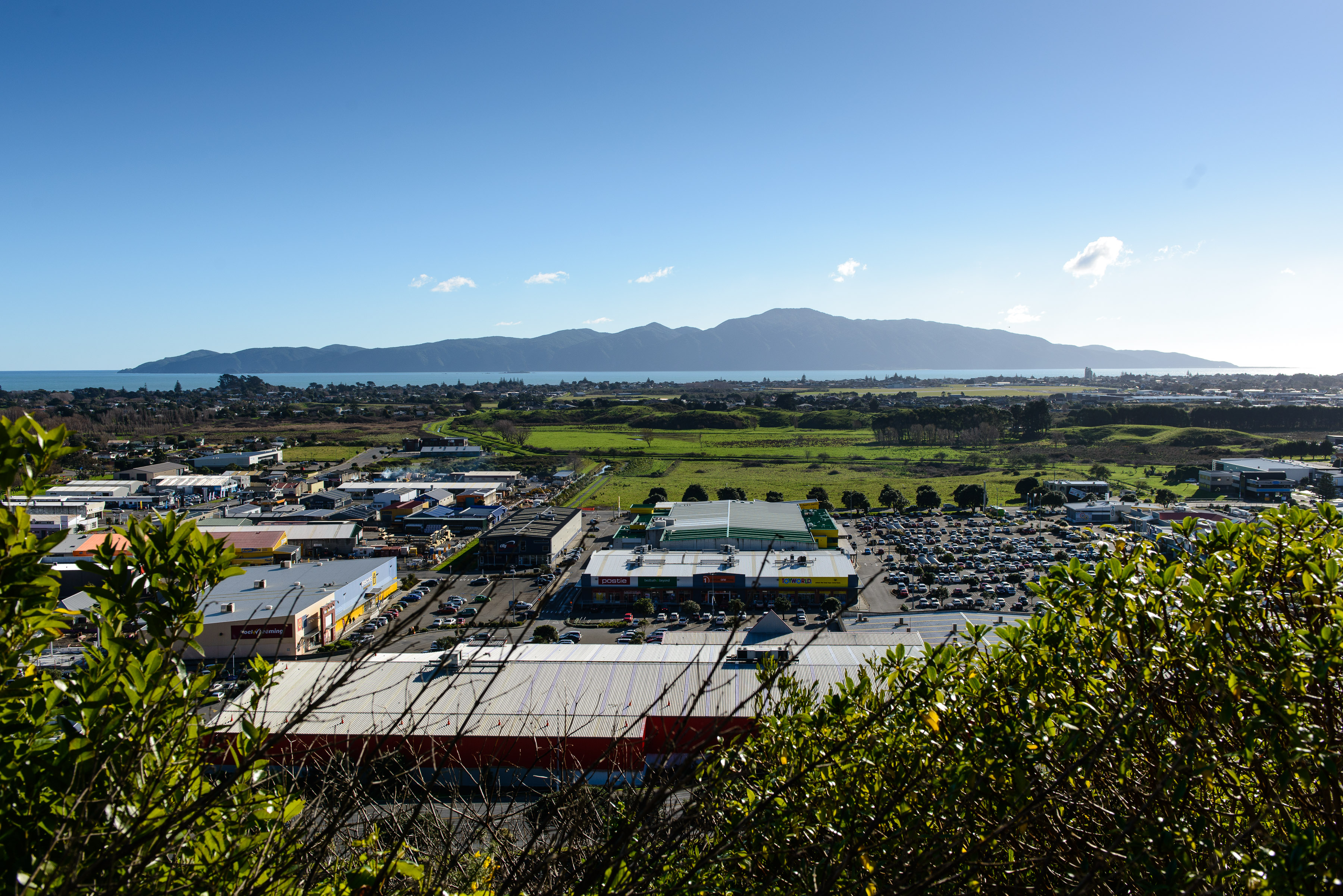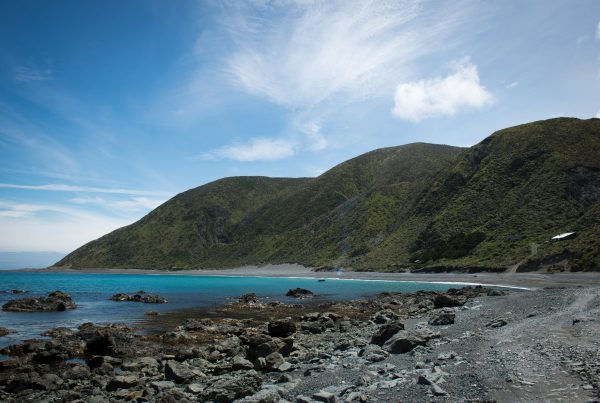
So there is much aside from the diesel fumes and tar that reeks about NZTA’s $12 billion Roads of National Significance (RoNS) project, one of New Zealand’s biggest infrastructure investments yet. The stated aim behind constructing this series of road links between Puhoi and Christchurch is to make the movement of freight and business traffic between ports, airports and markets in the five major population centres more efficient. Yet there is little evidence to suggest that the installation of a nationwide freight bypass without any genuine, localised urban planning of note will generate sweeping nationwide economic growth.
What is proven internationally is that motorways encourage people to live further from city centres and commute longer distances, leading to more urban sprawl and less efficient cities.* What is also proven is that large-scale ‘economic growth’ of the nature promised by government is unlikely to cause golden money showers to rain down on the taxpayers and road users footing the bill for the roads. Petrol tax, however, increased in July for the purpose, and anyone in business or retail may have noticed the instant increase in courier and goods supplier charges to keep up.
According to NZTA, 92 percent of freight is currently moved by road, and the total freight burden is forecast to increase. Yet even Mainfreight wants to see freight carried by rail, not least because trucks emit 4.6 times more CO2 per tonne per kilometre carried than trains. The auto industry, too, is seeing a significant decrease in sales, as reported by Time magazine in 2013. Younger generations are purchasing fewer cars, perhaps because they are living urban, environmentally aware, digitised lifestyles, or perhaps because they can’t afford them, or both. In any case, we may have passed the point of peak car usage.
Consider this alongside the fact that managing traffic congestion and the movement of freight both require sound planning and public transport, and that motorways do not guarantee economic growth but do lead to increased car use and urban sprawl. So why has NZTA been so vehement about their specific roading plans, including the flyover? What were the objections heard by the board? Importantly, will NZTA make an appeal in the High Court, and if so for what reasons, and to whose benefit?
Board of Inquiry
The Wellington Northern Corridor is the section of the RoNS project spanning the 110 kilometres from Wellington Airport to Levin. The highly contentious $90 million flyover (which NZTA insists on calling the ‘Basin Bridge’, since flyovers are now internationally outmoded) represented one out of the seven Wellington Northern Corridor RoNSs. The plan called for a 10-metre-high, one-way bridge to take vehicles from the Mt Victoria tunnel to just above the south end of Cambridge Terrace, passing in front of the Basin Reserve. Expected completion was 2017.
At the beginning of public consultation in 2008, Scoop reported that 79 percent of submissions were opposed to the flyover. Mayor Celia Wade-Brown has consistently opposed it, yet NZTA’s determination to realise government plans has been reflected in their relationship with local council. Last year, another Scoop report revealed that NZTA board member (and former Wellington deputy mayor) Alick Shaw and chief executive Geoff Dangerfield both presented Wellington Council with ultimatums, in a 2011 statement in the Dominion Post and a 2012 letter to council, respectively. These sent a clear message to council: no flyover, no funding for any regional roading construction. The major turning point in the council’s position, however, came in 2013 when councillor Andy Foster changed his previously anti-flyover vote. From then on, council was officially in favour and opposition was left to residents.
Perhaps in light of this, NZTA proceeded to pre-emptively move the historic Home of Compassion crèche building out of the path of the still unconsented flyover earlier this year. NZTA has consistently insisted that the building was moved in aid of the National War Memorial (NWM) Park project. However, on reviewing the evidence, the board decision states that “the only inference that can be drawn is that the crèche was moved to facilitate the building of the Basin Bridge… [and] the relocation… was not required for the completion of the NWM Park”.
NZTA was also already raring to go before Save Kapiti’s appeal against the Kapiti Expressway (detailed below) was complete. “We had [equipment] on site in preparation for construction, we were preparing the site,” media manager Anthony Frith says, clarifying that “there was no actual construction before that [Supreme Court] decision”.
The government-appointed board (retired Environment Court and District Court judge Gordon Whiting, social policy researcher James Baines, transportation consultant David Collins and resource management consultant David McMahon) considered over 350 submissions and statements from witnesses. Save the Basin campaigner Tim Jones believes the board may be put under pressure by NZTA to change their final decision, due 30 August, but have so far have been genuinely thorough in their investigations.
Still, the dice have been “loaded against opponents,” Jones says. “It is a highly asymmetric process… [in which] the government, for practical purposes, is a bottomless pit of funding.” On the other hand, Save the Basin received a $15,000 Environmental Protection Authority grant that only part-funded four months of legal fees and expertise. Like the Architectural Centre and Newtown Residents Association, they could not afford to fund their hardworking lawyers (Tom Bennion and Philip Milne, respectively) for the entire four-month period, so sometimes residents have taken on those roles. This has taken a heavy toll on locals, many of whom have suffered exhaustion and huge pressure on their work and family lives.
For Whom the Road Tolls
The urgency and lack of democratic process with which NZTA has been approaching the RoNS project is more understandable in light of the fact that the Road Transport Forum (RTF) donated almost $100,000 to the election campaign preceding National’s first term in 2008. The friendly relations between the National Party and the roads lobby seems to have made ensuing land transport policy a foregone conclusion, with the flyover a notable exception.
Former Green Party co-convenor Roland Sapsford explains how, between 2000 and 2002, Labour and the Greens cooperated to increase public transport funding by 250 percent. The associated New Zealand Transport Strategy was launched in 2002, and included a commitment to vehicle emissions testing, central funding for walking and cycling, and a major overhaul of land transport legislation. The Land Transport Management Act came into effect in 2003 and aimed to achieve an “integrated, safe, responsive and sustainable” land transport system.
These movements appear to have made the likes of the Business Roundtable, Auckland Chamber of Commerce and the roads lobby a wee bit nervous. “Criticism of the new policies began to appear in industry and trade magazines,” says Sapsford, “especially the business press, and a substantial lobbying campaign began at a local and regional government level. This was mediated through local chambers of commerce, as well as Automobile Association (AA) and RTF representatives on regional land transport committees.” In 2002, a conference titled The Case for Roads was held, from which an extract has been clipped on pages xx.
By 2004, the Allen Report had been commissioned by the AA with funding from the Auckland Chamber of Commerce, Infrastructure Auckland, BusinessNZ, Greater Wellington Regional Council and the RTF. It advocated for the expansion of roading investment with the rationale that this leads to economic growth. A 2006 report by the freshly established New Zealand Council for Infrastructure Development, partnered by Deutsche Bank, Fulton Hogan, BusinessNZ, New Zealand Contractors’ Federation and Multiplex Engineering, focused on transport infrastructure to 2025. This report advocated stable, long-term funding for heavy investment in state highways. Together with RTF reports in 2006 and 2007, it laid the foundation for the idea that future growth in freight movement by trucks means we need massive roading investment now.
Following the RTF’s $100,000 campaign donation, the successfully elected National Party sprung into gear. It created NZTA by merging Transit New Zealand — which used to research and propose roading projects — with Transfund, which assessed, ranked and funded them according to benefit-cost ratios and urgency. National also introduced the requirement that roading projects “give effect to” the Government Policy Statement on roads. This policy statement reflects the pro-roading agenda that had been gaining significant traction over the previous decade.
The Flyover

As stated, current traffic expertise internationally says that the congestion to which Frith refers cannot simply be built out of: it must be managed through public transport and urban design.* NZTA itself estimates that Transmission Gully will see 25 percent of commuters who would have taken the train on the road by 2026. Expressway plans also indicate that NZTA’s congestion management hasn’t been very thorough: these include a new major interchange on Kapiti Road, which already gets highly congested and has a traffic count very similar — if not greater — than State Highway 1.
The flyover plans included a 3‑metre-wide pedestrian-cycleway. Save the Basin’s Tim Jones’s response to the promised pedestrian-cycleway is telling: “Sarah Palin might not have done a lot for the world, but she did popularise the phrase, ‘you can’t put lipstick on a pig’.” He says that with wind speed increasing at elevation, the shared, narrow lane will make for unsafe journeys, particularly for children.
The cost of NZTA’s projected time saving also includes severe damage to residential areas and heritage sites. In a 2012 report, NZTA itself lists far more objections than benefits to the flyover, including negative impacts on ecology, heritage, sound and air quality, and urban design. Motorway pollution in residential areas is known to affect lung capacity and exacerbate lung, sleep, heart and hearing problems, as well as property values. One neighbouring Grandstand Apartment has reduced in value by $100,000. During the construction period, NZTA has further warned that residents may have to be relocated for as many as 200 nights so that noisy work can be undertaken.
Former Black Cap and New Zealand Cricket chief executive Martin Snedden wrote in Scoop that the flyover may spell the death of test match cricket and threaten the international status of the 148-year-old Basin Reserve, despite NZTA’s plans to construct a 12-metre-high ‘Northern Gateway Building’ to block the view of the road. These objections can be found among the (over) 150 others specific to the flyover that have been heard by the board and listed on the Environmental Protection Authority website.
The most alarming objection was perhaps that revealed in the Dominion Post last November. The board of inquiry requested a peer review from Abley Transportation Consultants of NZTA’s evidence for flyover plans. Abley found 49 issues, the most worrying being NZTA’s dismissive response to other roading options before seeking the public’s view on two flyover designs in 2011, with Abley itself finding two alternatives with equal merit. The Architecture Centre and opposition parties’ preferred solution (“Option X”) consists of a tunnel between Sussex Street and Taranaki Street that is safer and allows for better quality urban design than NZTA’s bridge. The tunnel also allows for the same designated bus lanes that NZTA claim as an advantage to their own plans.
[quote by=“Clint Eastwood and The Case for Roads”]
“And it does seem to me that one of the great mis-labellings of recent history is that the train was called the iron horse, but of course that’s wrong. The car was the iron horse. You see, when Clint Eastwood decides he has to clean up the town, he doesn’t go off to the carriage stock and get into the carriage and then go in and find another horse to go to where the bar is and shoot up the baddie. He goes out to his stable, climbs on to his horse, rides down, does his business, gets back on his horse, rides back home and has a scotch. The horse was private, point-to-point transport and that is how transport has been for most of history. And that is why the word for equality and equity has the same root as horse — equus. The horse was the great equaliser. So you can see that Clint in his western movies has powerful symbolic content. There are two equalisers at work.”[/quote]
The Expressway
Also heavily contested has been the $650 million, 16-kilometre Kapiti Expressway route from Raumati to Peka Peka, which boasts four lanes, three bridges, a four- to five-year construction period and the permanent defacing of nationally significant wetlands. The expressway was first designed in the 1950s: this was a decade in which motorways were considered good for economies (and in which the term ‘roads lobby’ was first coined).
The stated aims of the Kapiti Expressway were to alleviate traffic congestion and provide an emergency alternative route to State Highway 1. However, by the 1990s the expressway had still not been constructed and the designs were later deemed unnecessary, outdated, socially divisive and “poor urban planning” by NZTA itself. So in the 1990s an alternative was designed by world-class urban planner James Lunday, called the Western Link Road (WLR).
Lunday based his work on the principle that roads are to be designed around communities, not vice versa. So the WLR included fewer lanes, lower speed limits, cycleways, bridleways, walkways, and space for local business and activities. It was not a straight bypass designed for freight. Following several rounds of legal action, Lunday’s WLR was consented and entered Kapiti Council’s District Plan, which is of course legally binding. Much of the land was bought.
Then in 2009, then Minister of Transport, Steven Joyce overrode the council’s plans with a reinstatement of the old expressway designs, now part of the integrated RoNS project. Unsurprisingly, when ‘consultation’ begun that year regarding Kapiti’s preferred roading option for a State Highway 1 alternative, the process was biased. Save Kapiti’s Mark Harris recounts how the expressway option was suddenly and ambiguously reintroduced, heavily marketed, and costed without local roading elements factored in. The anti-expressway vote was then split between two options that both appeared relatively expensive due to their inclusion of costs for local road elements. The expressway was then set to get underway.
In Kapiti, previous mayor Jenny Rowan once passionately opposed the expressway, famously dubbing it the “highway from hell”. By 2013, she was stating that “it’s now time to let NZTA get on with the job, and for us to focus on getting the very best we can out of the project”. This meant negotiating over 300 conditions — from environmental protection to noise mitigation and cycleways.
Save Kapiti continued to appeal, however, on the grounds of NZTA not having sufficiently assessed James Lunday’s more socially and environmentally responsible WLR, and having illegally overridden district plans to build it. Last August, however, the Supreme Court decided in favour of NZTA. “In one of the most tortuous pieces of logic I have ever read,” says Harris, “…they said that as the existing proposal had yet to be built, and it and the new proposal couldn’t co-exist, the existing proposal was irrelevant and needn’t be considered.”
NZTA’s Frith says that the expressway route is safer “because it’s four lanes. It’s a more resilient route.” He adds, “It better provides for the traffic capacity. The WLR would have served a different purpose, it would have worked as a local arterial but what we’re looking at is something different. [The WLR] does not fulfil the needs of the project.”
For the sake of the expressway, many residents have been ousted from their homes permanently, with others seeing their community and living area significantly transformed and devalued. NZTA also initially planned to bulldoze through ancestral land in Waikanae that has belonged to descendants of Wi Parata since before 1840. Thanks to protests made by current owner Patricia Grace, that land is now being set aside as a Māori reservation.
The expressway promises 500 FTE jobs over the four- to five-year construction period and the kind of ‘big box’ development motorways bring (like the chain of fast-food outlets Paraparaumu already sports along State Highway 1). According to Save Kapiti, the 4,000 jobs the WLR offered included ongoing and local jobs. Even by the NZTA’s own calculations, the expressway achieves a benefit-cost ratio of only 0.23, where a rating of 1 would have been too low to warrant the construction of a project before National’s first term.
It is clear that NZTA is hell-bent on building the RoNS, and that there is more than public interest at stake. It seems they are still preparing for a future of road usage as though it were the 1950s — as though trains can’t move freight, traffic congestion can be built out of, and diesel fumes rain money and prosperity on taxpayers and communities. In a rare moment of cynicism, Tim Jones also suggests that here in New Zealand, “policy is cheap”. Yet July saw a hard won victory for Jones, fellow flyover opposition groups — and, in fact, any Wellingtonian in favour of sound and democratic urban design and transport planning.
*Information provided by a traffic expert who wished to remain anonymous.
[info]Timeline
1950s Initial designs for the Kapiti Expressway are made.
1990s Western Link Road designed by James Lunday.
2000-02 Labour and the Greens cooperate to increase public transport funding by 250 percent.
2002 New Zealand Transport Strategy launched.
2003 Land Transport Management Act comes into effect.
2002 Case for Roads conference.
2004 AA commissions the Allen Report, which advocates for expansion of roading investment.
2006-07 New Zealand Council for Infrastructure Development releases reports advocating for stable, long-term funding for heavy investment in state highways.
2008 Road Transport Forum donates almost $100,000 to National election campaign.
National merges Transit New Zealand and Transfund into one entity, the New Zealand Transport Agency (NZTA), and introduces the requirement that roading projects also “give effect to” the Government Policy Statement on roads.
Roads of National Significance (RoNS) plan kicks into action under then transport minister Steven Joyce.
Flyover consultation begins, with 79 percent submissions opposing the plan.
2009 National overrides Kapiti Council’s District Plan to build the Western Link Road by reintroducing the Kapiti Expressway, which fits into the RoNS plan.
2011 Public consultation on flyover takes place.
2013 Save Kapiti take their appeal through the High Court and into the Supreme Court, but NZTA prevails.
Councillor Andy Foster changes his vote on the flyover, meaning the council is in favour and opposition is left to residents.
2014 Patricia Grace’s appeal to have the Kapiti Expressway rerouted to avoid Māori land is successful.
22 July The board announces draft decision to decline resource consent for the flyover.
15 August Deadline for comment on draft decision.
30 August Final decision and report due. Assuming the final decision is unchanged, this will likely be followed by an appeal in the High Court from NZTA.[/info]








